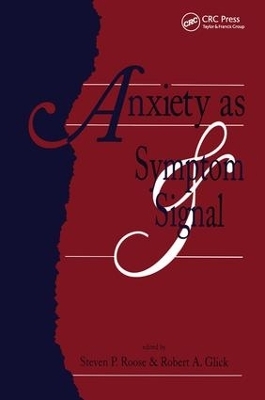
Anxiety as Symptom and Signal
Routledge (Verlag)
978-1-138-88156-3 (ISBN)
The illuminating, readable collection will broaden clinicians' awareness of the diverse research findings that now inform our understanding of anxiety. No less importantly, it will deepen their appreciation of the richly variegated ways that anxiety can shape, and be shaped by, the clinical process.
Steven P. Roose, M.D., is a faculty member of the Columbia University Center for Psychoanalytic Training and Research, and Associate Professor of Clinical Psychiatry at the Columbia University College of Physicians and Surgeons. Robert A. Glick, M.D., is a Training and Supervising Analyst at the Columbia University Center for Psychoanalytic Training and Research, and Clinical Professor of Psychiatry at the Columbia University College of Physicians and Surgeons.
Glick, Freudian and Post-Freudian Theories of Anxiety. Part I: Anxiety as Symptom: The Mind and the Brain.Hofer, An Evolutionary Perspective on Anxiety. Gorman, Papp, & Coplan, Neuroanatomy and Neurotransmitter Function in Panic Disorder. Fyer, Genetic and Temperamental Variations in Individual Predisposition to Anxiety. Dowling, The Ontogeny and Dynamics of Anxiety in Childhood. Part II: Anxiety as Signal: The Treatment Setting.Fogel, Learning to Be Anxious. Stern, Anxiety and Resistance to Changes in Self-Concept. Renik, The Patient's Anxiety, the Therapist's Anxiety, and the Therapeutic Process. Spezzano, A Relational Perspective on Anxiety. Roose, Does Anxiety Obstruct of Motivate Treatment? When to Talk, When to Prescribe, and When to do Both. Reis, Epilogue.
| Erscheint lt. Verlag | 21.1.2019 |
|---|---|
| Verlagsort | London |
| Sprache | englisch |
| Maße | 152 x 229 mm |
| Gewicht | 453 g |
| Themenwelt | Sachbuch/Ratgeber ► Gesundheit / Leben / Psychologie ► Psychologie |
| Geisteswissenschaften ► Psychologie ► Angst / Depression / Zwang | |
| Geisteswissenschaften ► Psychologie ► Persönlichkeitsstörungen | |
| Geisteswissenschaften ► Psychologie ► Psychoanalyse / Tiefenpsychologie | |
| Geisteswissenschaften ► Sprach- / Literaturwissenschaft ► Anglistik / Amerikanistik | |
| Geisteswissenschaften ► Sprach- / Literaturwissenschaft ► Literaturwissenschaft | |
| Medizin / Pharmazie ► Medizinische Fachgebiete ► Psychiatrie / Psychotherapie | |
| ISBN-10 | 1-138-88156-2 / 1138881562 |
| ISBN-13 | 978-1-138-88156-3 / 9781138881563 |
| Zustand | Neuware |
| Haben Sie eine Frage zum Produkt? |
aus dem Bereich


